Global Financial Institutions and Market Assessment
VerifiedAdded on 2020/04/13
|12
|2432
|45
Report
AI Summary
This report provides a comprehensive analysis of global financial institutions and market dynamics. It begins by examining the role of government in regulating financial markets and the use of stimulative monetary policies to influence economic growth. The report then delves into money market securities, corporate bonds, and the bond market's structure. It discusses stock valuation methods, including fundamental and technical analysis, and the use of the Sharpe index to measure excess returns. The report also covers the process of initial public offerings (IPOs), including the steps involved in going public and the role of underwriters in stabilizing stock prices. Finally, it explores potential abuses within the IPO market. This report provides valuable insights into the functioning of financial markets and the key elements that shape them.
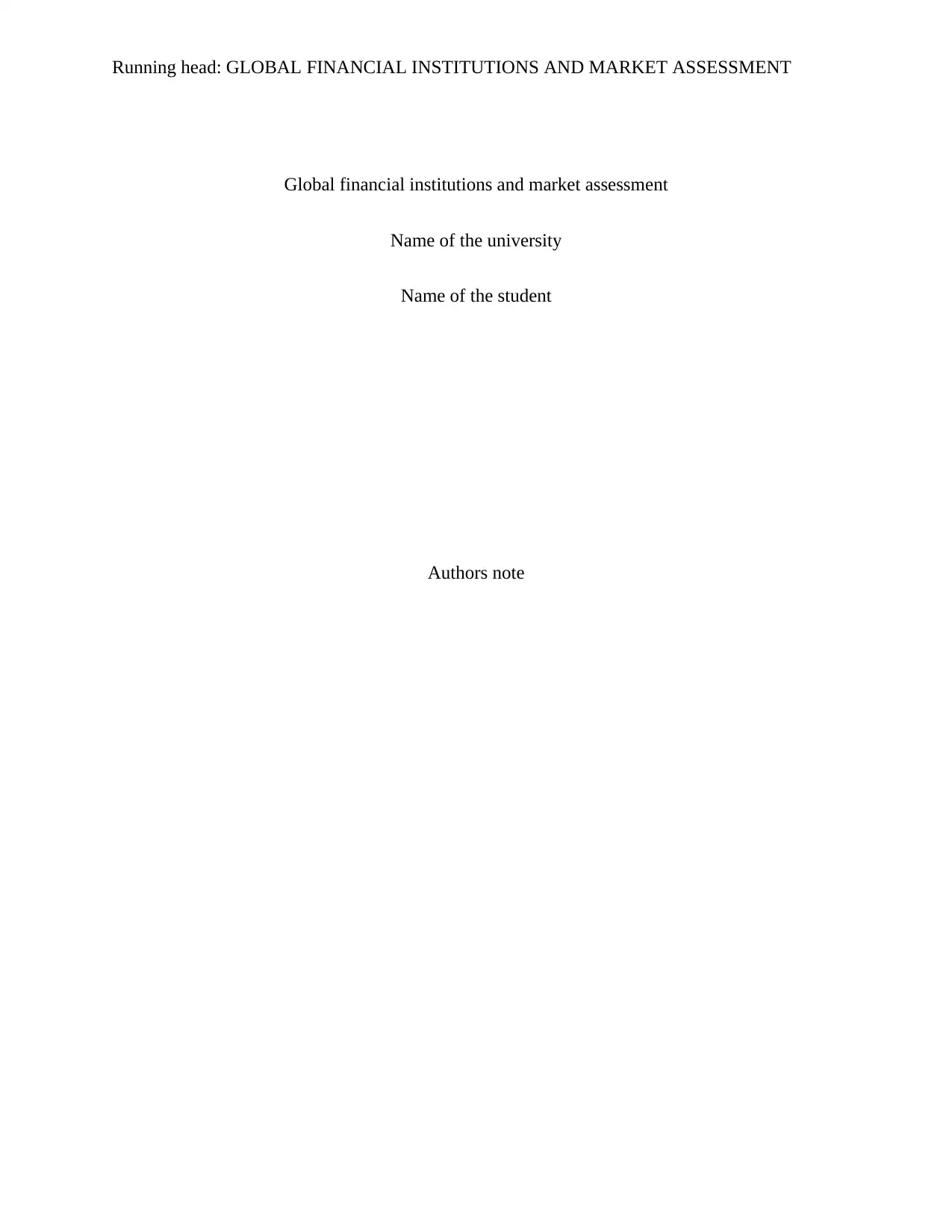
Running head: GLOBAL FINANCIAL INSTITUTIONS AND MARKET ASSESSMENT
Global financial institutions and market assessment
Name of the university
Name of the student
Authors note
Global financial institutions and market assessment
Name of the university
Name of the student
Authors note
Paraphrase This Document
Need a fresh take? Get an instant paraphrase of this document with our AI Paraphraser
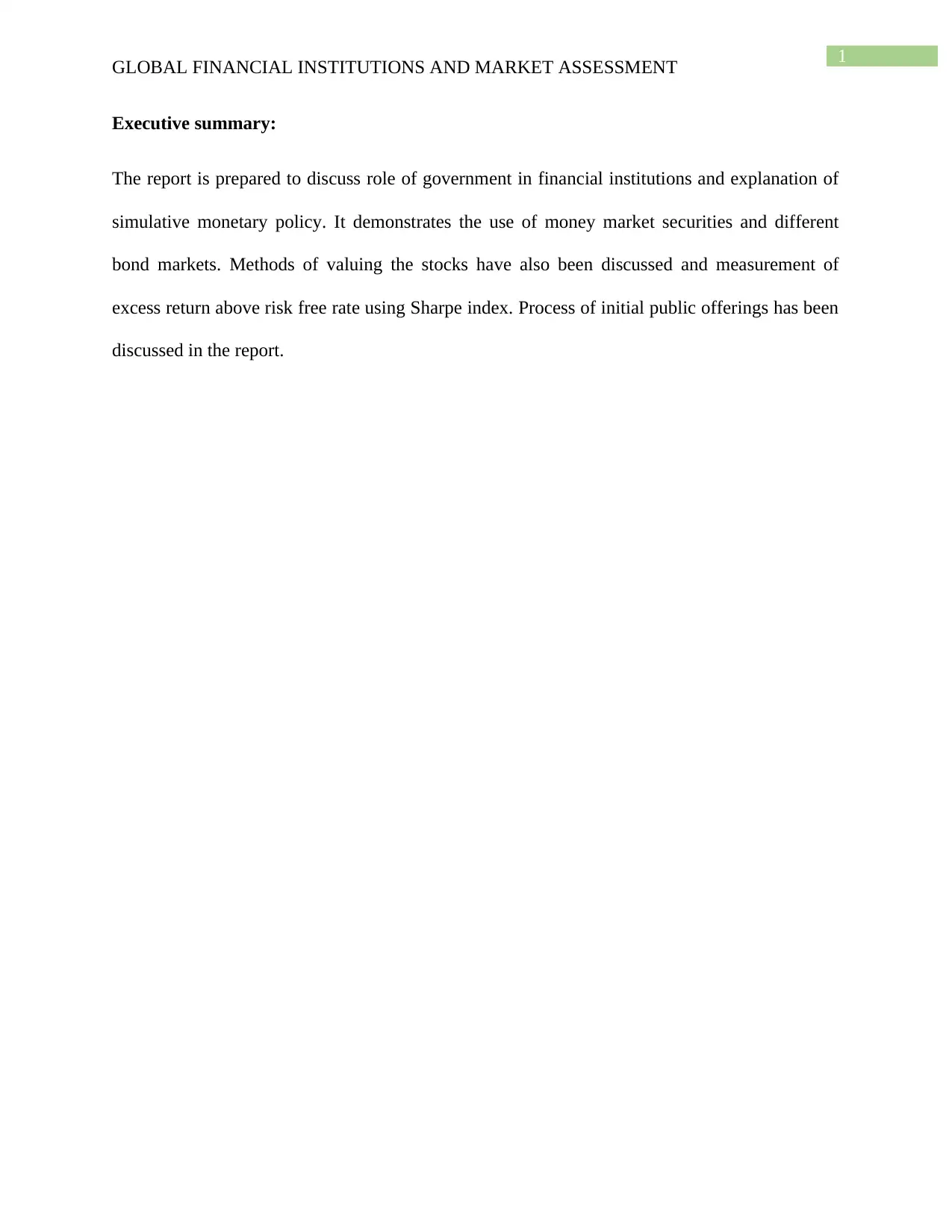
1
GLOBAL FINANCIAL INSTITUTIONS AND MARKET ASSESSMENT
Executive summary:
The report is prepared to discuss role of government in financial institutions and explanation of
simulative monetary policy. It demonstrates the use of money market securities and different
bond markets. Methods of valuing the stocks have also been discussed and measurement of
excess return above risk free rate using Sharpe index. Process of initial public offerings has been
discussed in the report.
GLOBAL FINANCIAL INSTITUTIONS AND MARKET ASSESSMENT
Executive summary:
The report is prepared to discuss role of government in financial institutions and explanation of
simulative monetary policy. It demonstrates the use of money market securities and different
bond markets. Methods of valuing the stocks have also been discussed and measurement of
excess return above risk free rate using Sharpe index. Process of initial public offerings has been
discussed in the report.
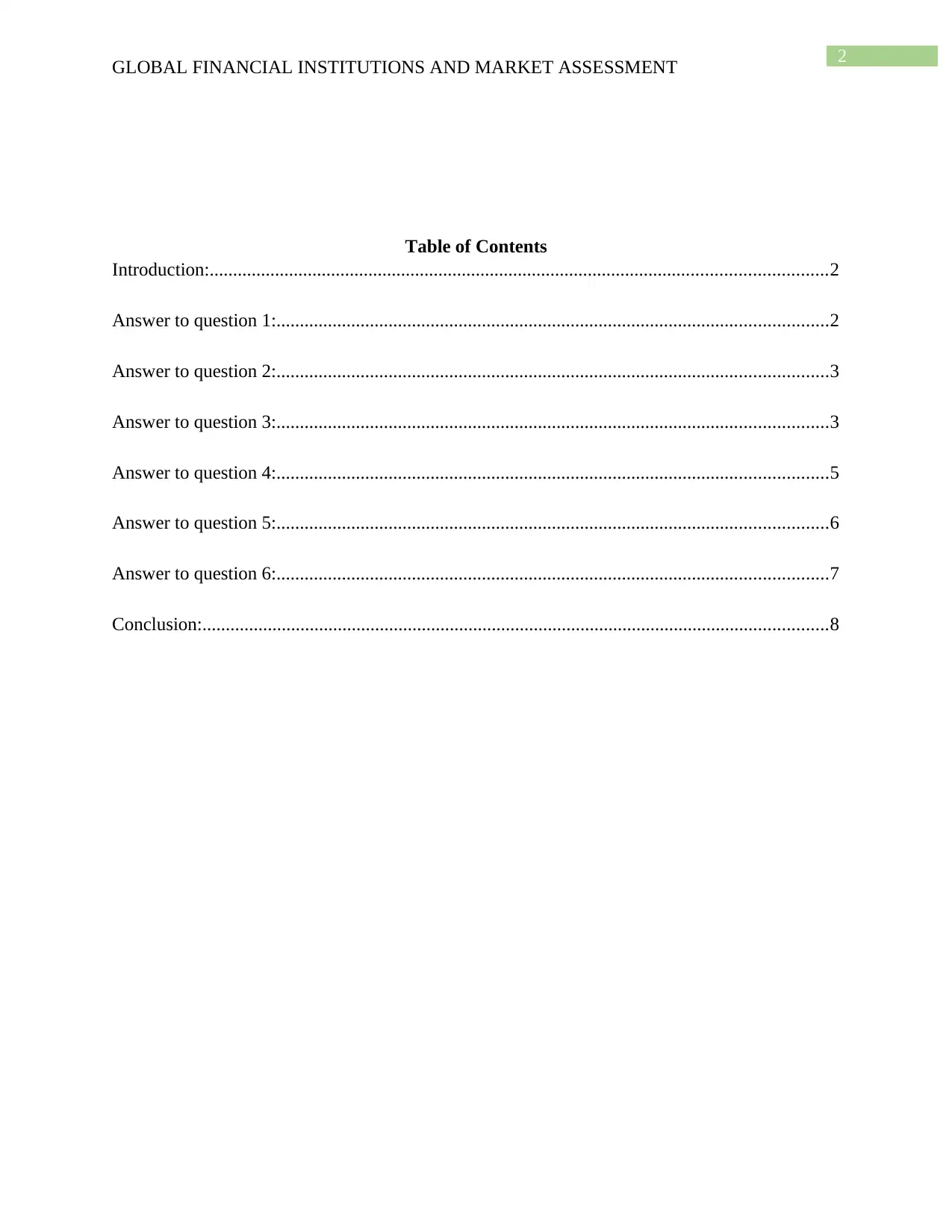
2
GLOBAL FINANCIAL INSTITUTIONS AND MARKET ASSESSMENT
Table of Contents
Introduction:....................................................................................................................................2
Answer to question 1:......................................................................................................................2
Answer to question 2:......................................................................................................................3
Answer to question 3:......................................................................................................................3
Answer to question 4:......................................................................................................................5
Answer to question 5:......................................................................................................................6
Answer to question 6:......................................................................................................................7
Conclusion:......................................................................................................................................8
GLOBAL FINANCIAL INSTITUTIONS AND MARKET ASSESSMENT
Table of Contents
Introduction:....................................................................................................................................2
Answer to question 1:......................................................................................................................2
Answer to question 2:......................................................................................................................3
Answer to question 3:......................................................................................................................3
Answer to question 4:......................................................................................................................5
Answer to question 5:......................................................................................................................6
Answer to question 6:......................................................................................................................7
Conclusion:......................................................................................................................................8
⊘ This is a preview!⊘
Do you want full access?
Subscribe today to unlock all pages.

Trusted by 1+ million students worldwide
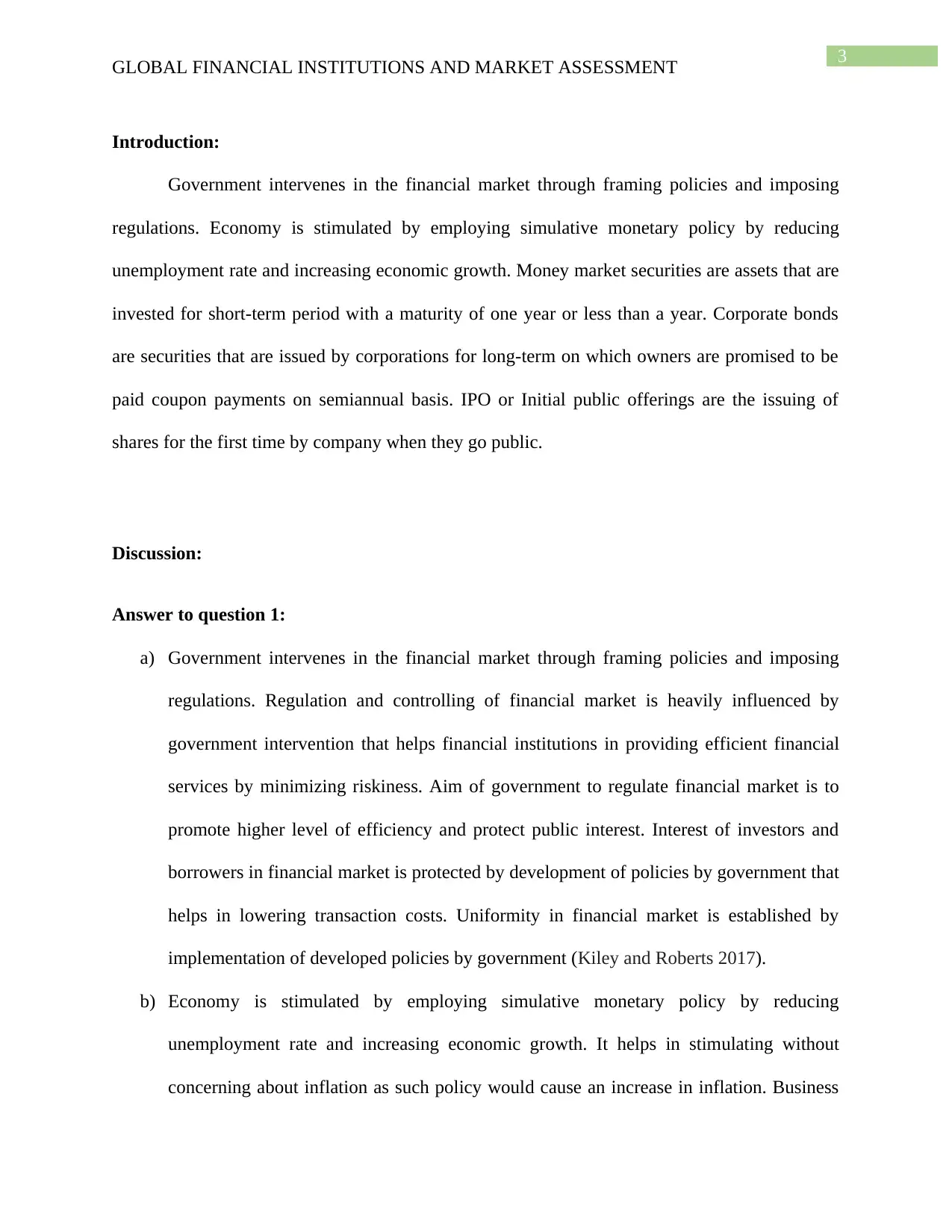
3
GLOBAL FINANCIAL INSTITUTIONS AND MARKET ASSESSMENT
Introduction:
Government intervenes in the financial market through framing policies and imposing
regulations. Economy is stimulated by employing simulative monetary policy by reducing
unemployment rate and increasing economic growth. Money market securities are assets that are
invested for short-term period with a maturity of one year or less than a year. Corporate bonds
are securities that are issued by corporations for long-term on which owners are promised to be
paid coupon payments on semiannual basis. IPO or Initial public offerings are the issuing of
shares for the first time by company when they go public.
Discussion:
Answer to question 1:
a) Government intervenes in the financial market through framing policies and imposing
regulations. Regulation and controlling of financial market is heavily influenced by
government intervention that helps financial institutions in providing efficient financial
services by minimizing riskiness. Aim of government to regulate financial market is to
promote higher level of efficiency and protect public interest. Interest of investors and
borrowers in financial market is protected by development of policies by government that
helps in lowering transaction costs. Uniformity in financial market is established by
implementation of developed policies by government (Kiley and Roberts 2017).
b) Economy is stimulated by employing simulative monetary policy by reducing
unemployment rate and increasing economic growth. It helps in stimulating without
concerning about inflation as such policy would cause an increase in inflation. Business
GLOBAL FINANCIAL INSTITUTIONS AND MARKET ASSESSMENT
Introduction:
Government intervenes in the financial market through framing policies and imposing
regulations. Economy is stimulated by employing simulative monetary policy by reducing
unemployment rate and increasing economic growth. Money market securities are assets that are
invested for short-term period with a maturity of one year or less than a year. Corporate bonds
are securities that are issued by corporations for long-term on which owners are promised to be
paid coupon payments on semiannual basis. IPO or Initial public offerings are the issuing of
shares for the first time by company when they go public.
Discussion:
Answer to question 1:
a) Government intervenes in the financial market through framing policies and imposing
regulations. Regulation and controlling of financial market is heavily influenced by
government intervention that helps financial institutions in providing efficient financial
services by minimizing riskiness. Aim of government to regulate financial market is to
promote higher level of efficiency and protect public interest. Interest of investors and
borrowers in financial market is protected by development of policies by government that
helps in lowering transaction costs. Uniformity in financial market is established by
implementation of developed policies by government (Kiley and Roberts 2017).
b) Economy is stimulated by employing simulative monetary policy by reducing
unemployment rate and increasing economic growth. It helps in stimulating without
concerning about inflation as such policy would cause an increase in inflation. Business
Paraphrase This Document
Need a fresh take? Get an instant paraphrase of this document with our AI Paraphraser
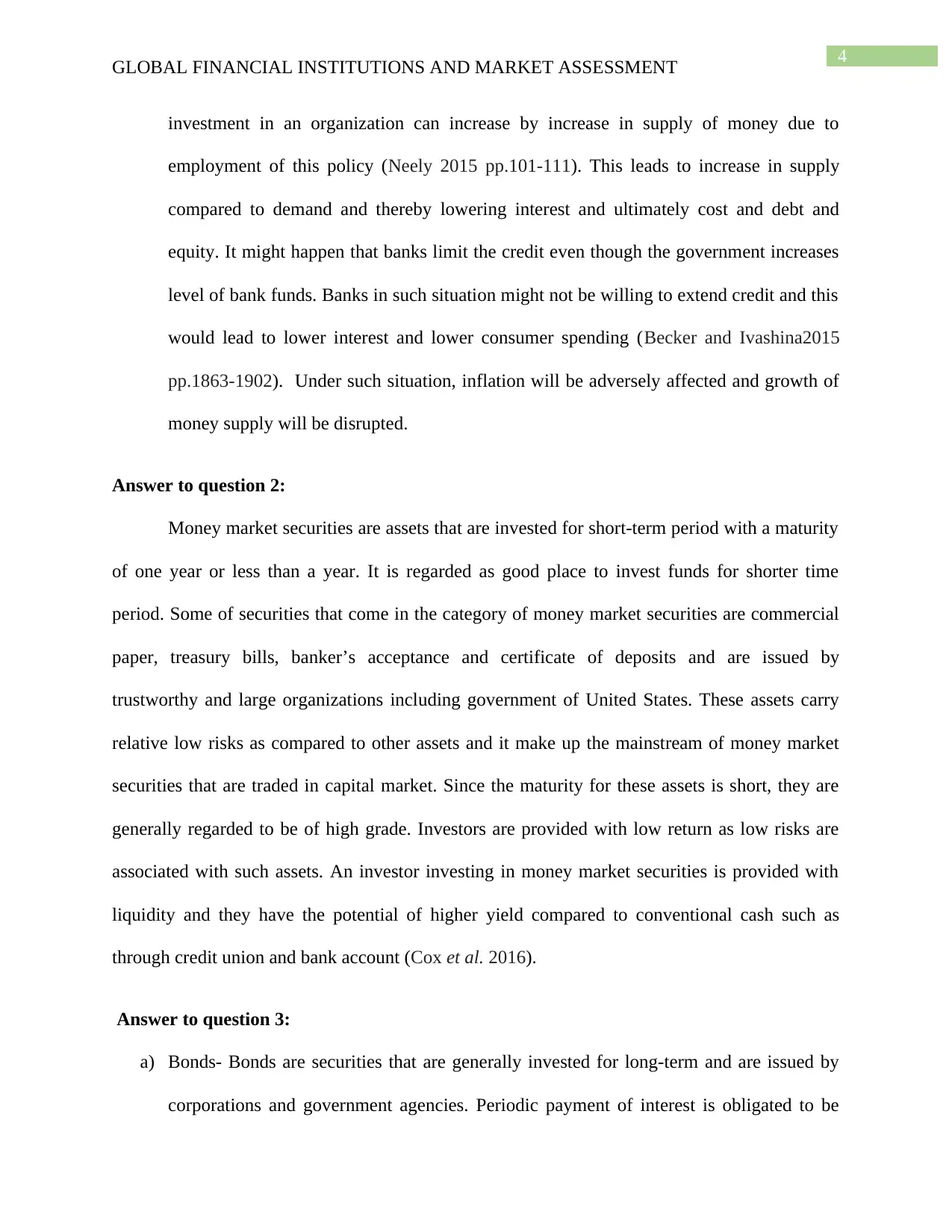
4
GLOBAL FINANCIAL INSTITUTIONS AND MARKET ASSESSMENT
investment in an organization can increase by increase in supply of money due to
employment of this policy (Neely 2015 pp.101-111). This leads to increase in supply
compared to demand and thereby lowering interest and ultimately cost and debt and
equity. It might happen that banks limit the credit even though the government increases
level of bank funds. Banks in such situation might not be willing to extend credit and this
would lead to lower interest and lower consumer spending (Becker and Ivashina2015
pp.1863-1902). Under such situation, inflation will be adversely affected and growth of
money supply will be disrupted.
Answer to question 2:
Money market securities are assets that are invested for short-term period with a maturity
of one year or less than a year. It is regarded as good place to invest funds for shorter time
period. Some of securities that come in the category of money market securities are commercial
paper, treasury bills, banker’s acceptance and certificate of deposits and are issued by
trustworthy and large organizations including government of United States. These assets carry
relative low risks as compared to other assets and it make up the mainstream of money market
securities that are traded in capital market. Since the maturity for these assets is short, they are
generally regarded to be of high grade. Investors are provided with low return as low risks are
associated with such assets. An investor investing in money market securities is provided with
liquidity and they have the potential of higher yield compared to conventional cash such as
through credit union and bank account (Cox et al. 2016).
Answer to question 3:
a) Bonds- Bonds are securities that are generally invested for long-term and are issued by
corporations and government agencies. Periodic payment of interest is obligated to be
GLOBAL FINANCIAL INSTITUTIONS AND MARKET ASSESSMENT
investment in an organization can increase by increase in supply of money due to
employment of this policy (Neely 2015 pp.101-111). This leads to increase in supply
compared to demand and thereby lowering interest and ultimately cost and debt and
equity. It might happen that banks limit the credit even though the government increases
level of bank funds. Banks in such situation might not be willing to extend credit and this
would lead to lower interest and lower consumer spending (Becker and Ivashina2015
pp.1863-1902). Under such situation, inflation will be adversely affected and growth of
money supply will be disrupted.
Answer to question 2:
Money market securities are assets that are invested for short-term period with a maturity
of one year or less than a year. It is regarded as good place to invest funds for shorter time
period. Some of securities that come in the category of money market securities are commercial
paper, treasury bills, banker’s acceptance and certificate of deposits and are issued by
trustworthy and large organizations including government of United States. These assets carry
relative low risks as compared to other assets and it make up the mainstream of money market
securities that are traded in capital market. Since the maturity for these assets is short, they are
generally regarded to be of high grade. Investors are provided with low return as low risks are
associated with such assets. An investor investing in money market securities is provided with
liquidity and they have the potential of higher yield compared to conventional cash such as
through credit union and bank account (Cox et al. 2016).
Answer to question 3:
a) Bonds- Bonds are securities that are generally invested for long-term and are issued by
corporations and government agencies. Periodic payment of interest is obligated to be
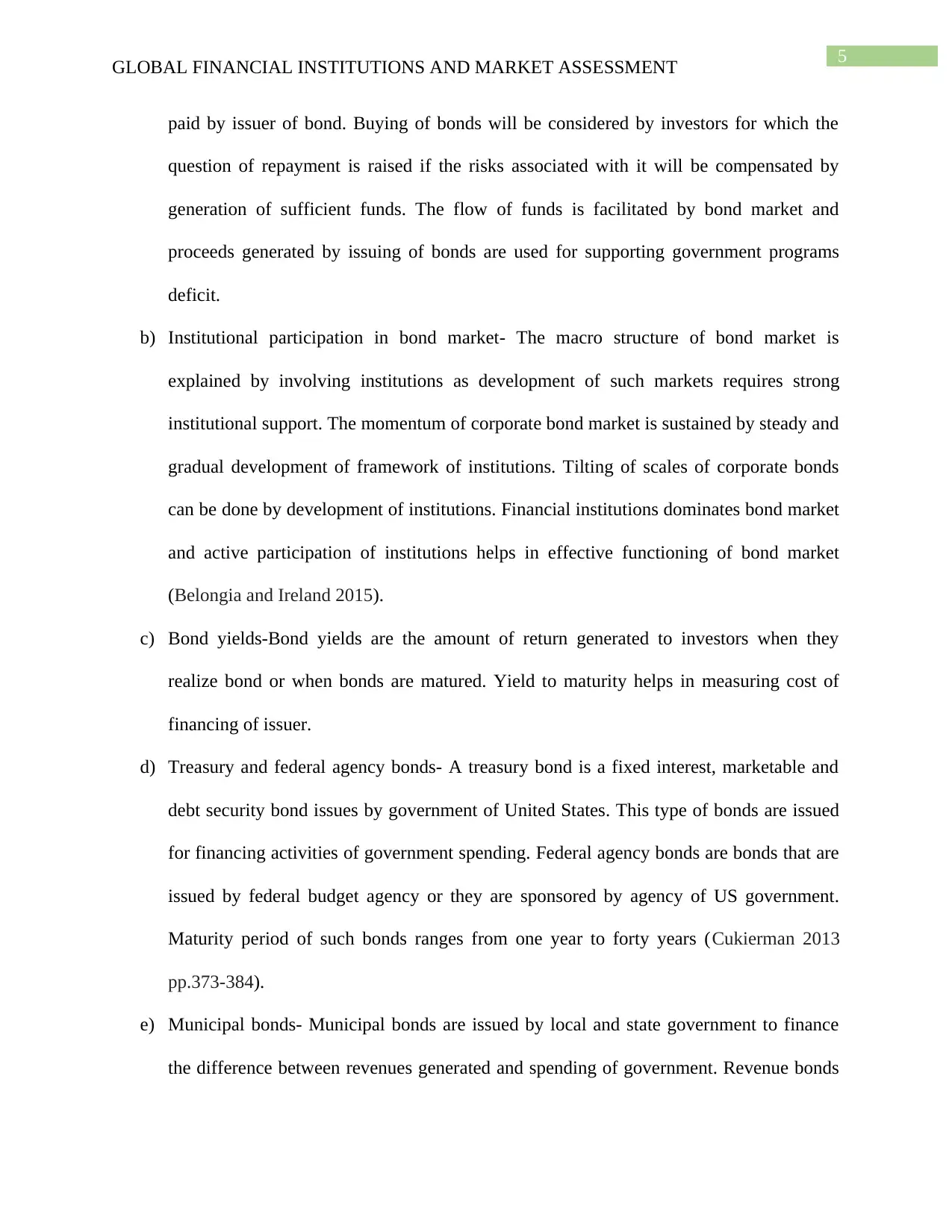
5
GLOBAL FINANCIAL INSTITUTIONS AND MARKET ASSESSMENT
paid by issuer of bond. Buying of bonds will be considered by investors for which the
question of repayment is raised if the risks associated with it will be compensated by
generation of sufficient funds. The flow of funds is facilitated by bond market and
proceeds generated by issuing of bonds are used for supporting government programs
deficit.
b) Institutional participation in bond market- The macro structure of bond market is
explained by involving institutions as development of such markets requires strong
institutional support. The momentum of corporate bond market is sustained by steady and
gradual development of framework of institutions. Tilting of scales of corporate bonds
can be done by development of institutions. Financial institutions dominates bond market
and active participation of institutions helps in effective functioning of bond market
(Belongia and Ireland 2015).
c) Bond yields-Bond yields are the amount of return generated to investors when they
realize bond or when bonds are matured. Yield to maturity helps in measuring cost of
financing of issuer.
d) Treasury and federal agency bonds- A treasury bond is a fixed interest, marketable and
debt security bond issues by government of United States. This type of bonds are issued
for financing activities of government spending. Federal agency bonds are bonds that are
issued by federal budget agency or they are sponsored by agency of US government.
Maturity period of such bonds ranges from one year to forty years (Cukierman 2013
pp.373-384).
e) Municipal bonds- Municipal bonds are issued by local and state government to finance
the difference between revenues generated and spending of government. Revenue bonds
GLOBAL FINANCIAL INSTITUTIONS AND MARKET ASSESSMENT
paid by issuer of bond. Buying of bonds will be considered by investors for which the
question of repayment is raised if the risks associated with it will be compensated by
generation of sufficient funds. The flow of funds is facilitated by bond market and
proceeds generated by issuing of bonds are used for supporting government programs
deficit.
b) Institutional participation in bond market- The macro structure of bond market is
explained by involving institutions as development of such markets requires strong
institutional support. The momentum of corporate bond market is sustained by steady and
gradual development of framework of institutions. Tilting of scales of corporate bonds
can be done by development of institutions. Financial institutions dominates bond market
and active participation of institutions helps in effective functioning of bond market
(Belongia and Ireland 2015).
c) Bond yields-Bond yields are the amount of return generated to investors when they
realize bond or when bonds are matured. Yield to maturity helps in measuring cost of
financing of issuer.
d) Treasury and federal agency bonds- A treasury bond is a fixed interest, marketable and
debt security bond issues by government of United States. This type of bonds are issued
for financing activities of government spending. Federal agency bonds are bonds that are
issued by federal budget agency or they are sponsored by agency of US government.
Maturity period of such bonds ranges from one year to forty years (Cukierman 2013
pp.373-384).
e) Municipal bonds- Municipal bonds are issued by local and state government to finance
the difference between revenues generated and spending of government. Revenue bonds
⊘ This is a preview!⊘
Do you want full access?
Subscribe today to unlock all pages.

Trusted by 1+ million students worldwide
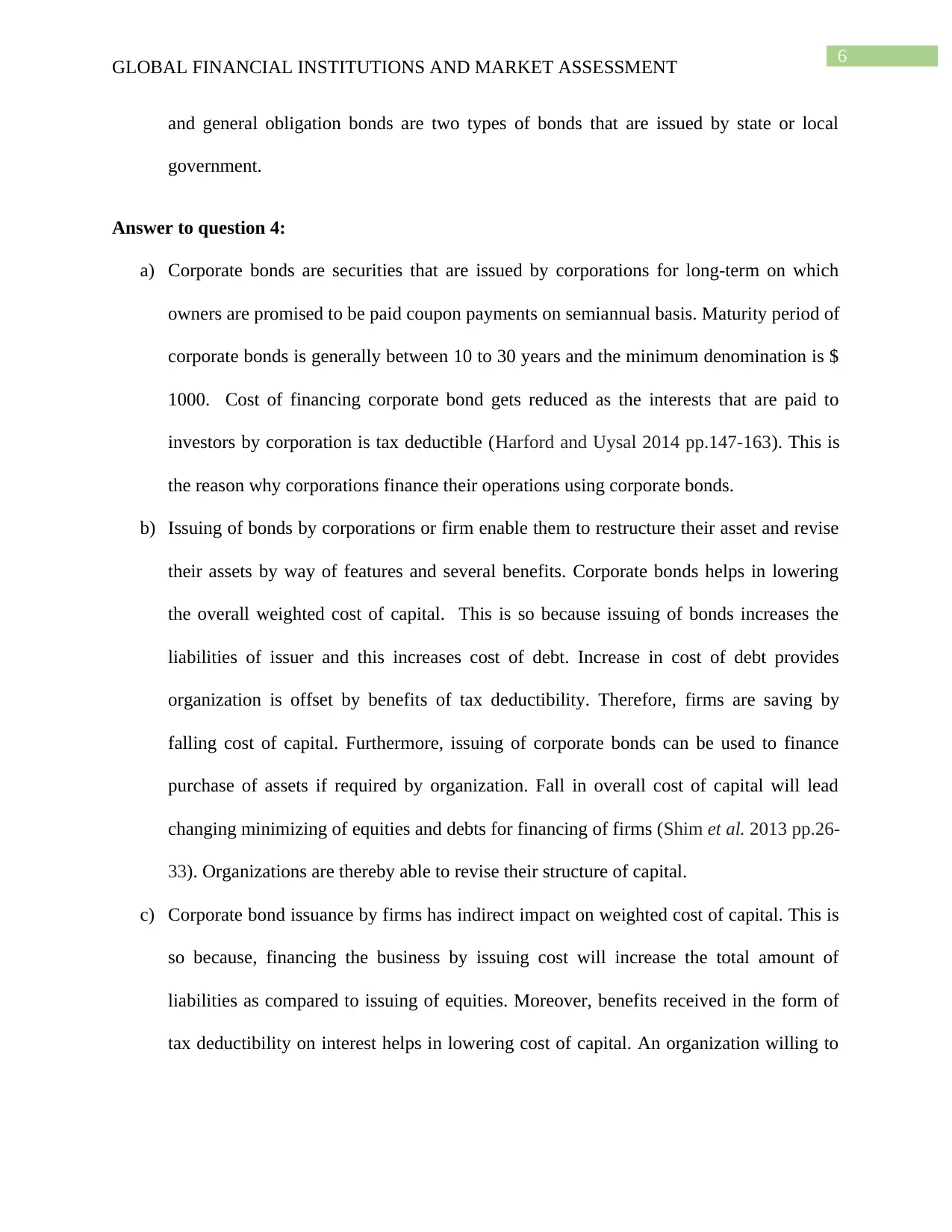
6
GLOBAL FINANCIAL INSTITUTIONS AND MARKET ASSESSMENT
and general obligation bonds are two types of bonds that are issued by state or local
government.
Answer to question 4:
a) Corporate bonds are securities that are issued by corporations for long-term on which
owners are promised to be paid coupon payments on semiannual basis. Maturity period of
corporate bonds is generally between 10 to 30 years and the minimum denomination is $
1000. Cost of financing corporate bond gets reduced as the interests that are paid to
investors by corporation is tax deductible (Harford and Uysal 2014 pp.147-163). This is
the reason why corporations finance their operations using corporate bonds.
b) Issuing of bonds by corporations or firm enable them to restructure their asset and revise
their assets by way of features and several benefits. Corporate bonds helps in lowering
the overall weighted cost of capital. This is so because issuing of bonds increases the
liabilities of issuer and this increases cost of debt. Increase in cost of debt provides
organization is offset by benefits of tax deductibility. Therefore, firms are saving by
falling cost of capital. Furthermore, issuing of corporate bonds can be used to finance
purchase of assets if required by organization. Fall in overall cost of capital will lead
changing minimizing of equities and debts for financing of firms (Shim et al. 2013 pp.26-
33). Organizations are thereby able to revise their structure of capital.
c) Corporate bond issuance by firms has indirect impact on weighted cost of capital. This is
so because, financing the business by issuing cost will increase the total amount of
liabilities as compared to issuing of equities. Moreover, benefits received in the form of
tax deductibility on interest helps in lowering cost of capital. An organization willing to
GLOBAL FINANCIAL INSTITUTIONS AND MARKET ASSESSMENT
and general obligation bonds are two types of bonds that are issued by state or local
government.
Answer to question 4:
a) Corporate bonds are securities that are issued by corporations for long-term on which
owners are promised to be paid coupon payments on semiannual basis. Maturity period of
corporate bonds is generally between 10 to 30 years and the minimum denomination is $
1000. Cost of financing corporate bond gets reduced as the interests that are paid to
investors by corporation is tax deductible (Harford and Uysal 2014 pp.147-163). This is
the reason why corporations finance their operations using corporate bonds.
b) Issuing of bonds by corporations or firm enable them to restructure their asset and revise
their assets by way of features and several benefits. Corporate bonds helps in lowering
the overall weighted cost of capital. This is so because issuing of bonds increases the
liabilities of issuer and this increases cost of debt. Increase in cost of debt provides
organization is offset by benefits of tax deductibility. Therefore, firms are saving by
falling cost of capital. Furthermore, issuing of corporate bonds can be used to finance
purchase of assets if required by organization. Fall in overall cost of capital will lead
changing minimizing of equities and debts for financing of firms (Shim et al. 2013 pp.26-
33). Organizations are thereby able to revise their structure of capital.
c) Corporate bond issuance by firms has indirect impact on weighted cost of capital. This is
so because, financing the business by issuing cost will increase the total amount of
liabilities as compared to issuing of equities. Moreover, benefits received in the form of
tax deductibility on interest helps in lowering cost of capital. An organization willing to
Paraphrase This Document
Need a fresh take? Get an instant paraphrase of this document with our AI Paraphraser
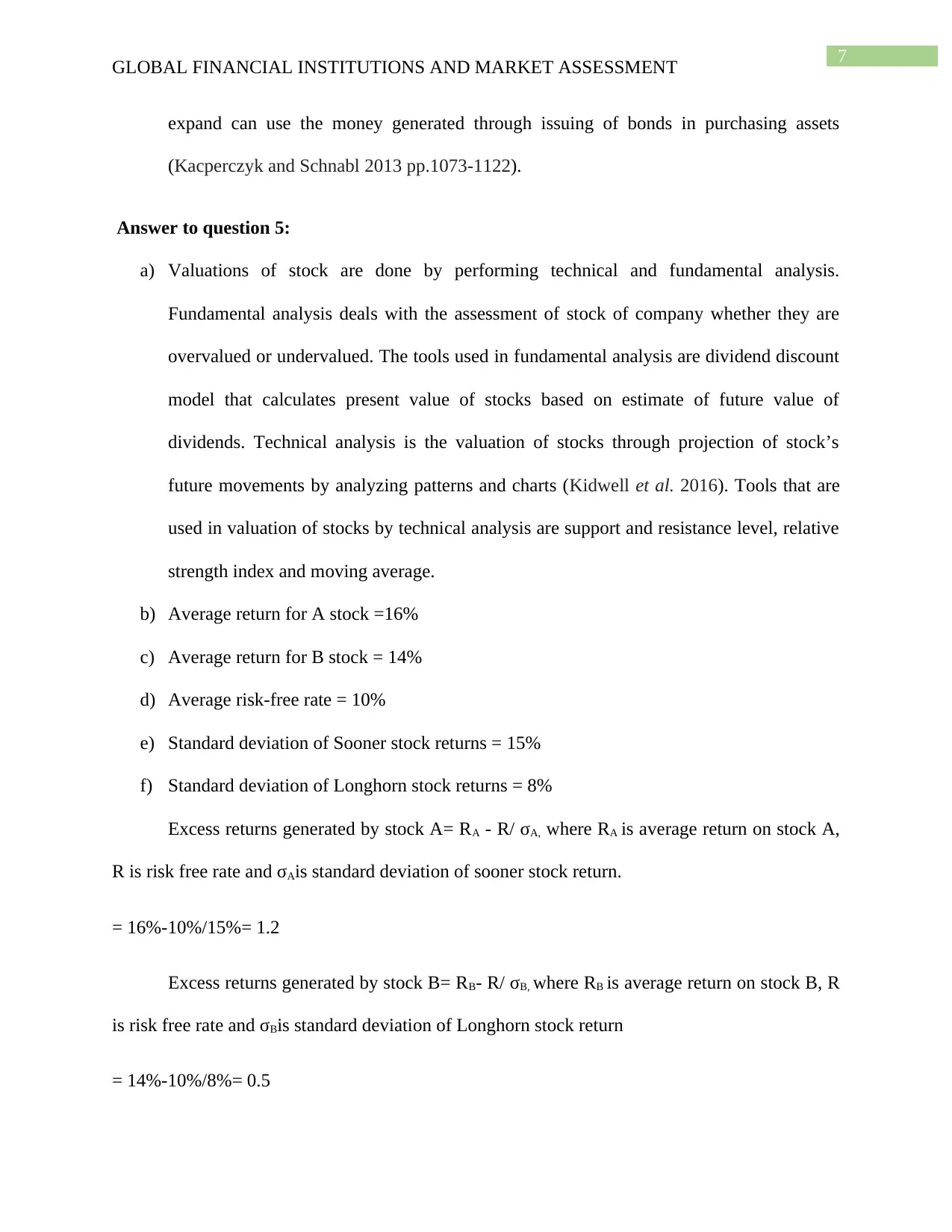
7
GLOBAL FINANCIAL INSTITUTIONS AND MARKET ASSESSMENT
expand can use the money generated through issuing of bonds in purchasing assets
(Kacperczyk and Schnabl 2013 pp.1073-1122).
Answer to question 5:
a) Valuations of stock are done by performing technical and fundamental analysis.
Fundamental analysis deals with the assessment of stock of company whether they are
overvalued or undervalued. The tools used in fundamental analysis are dividend discount
model that calculates present value of stocks based on estimate of future value of
dividends. Technical analysis is the valuation of stocks through projection of stock’s
future movements by analyzing patterns and charts (Kidwell et al. 2016). Tools that are
used in valuation of stocks by technical analysis are support and resistance level, relative
strength index and moving average.
b) Average return for A stock =16%
c) Average return for B stock = 14%
d) Average risk-free rate = 10%
e) Standard deviation of Sooner stock returns = 15%
f) Standard deviation of Longhorn stock returns = 8%
Excess returns generated by stock A= RA - R/ σA, where RA is average return on stock A,
R is risk free rate and σAis standard deviation of sooner stock return.
= 16%-10%/15%= 1.2
Excess returns generated by stock B= RB- R/ σB, where RB is average return on stock B, R
is risk free rate and σBis standard deviation of Longhorn stock return
= 14%-10%/8%= 0.5
GLOBAL FINANCIAL INSTITUTIONS AND MARKET ASSESSMENT
expand can use the money generated through issuing of bonds in purchasing assets
(Kacperczyk and Schnabl 2013 pp.1073-1122).
Answer to question 5:
a) Valuations of stock are done by performing technical and fundamental analysis.
Fundamental analysis deals with the assessment of stock of company whether they are
overvalued or undervalued. The tools used in fundamental analysis are dividend discount
model that calculates present value of stocks based on estimate of future value of
dividends. Technical analysis is the valuation of stocks through projection of stock’s
future movements by analyzing patterns and charts (Kidwell et al. 2016). Tools that are
used in valuation of stocks by technical analysis are support and resistance level, relative
strength index and moving average.
b) Average return for A stock =16%
c) Average return for B stock = 14%
d) Average risk-free rate = 10%
e) Standard deviation of Sooner stock returns = 15%
f) Standard deviation of Longhorn stock returns = 8%
Excess returns generated by stock A= RA - R/ σA, where RA is average return on stock A,
R is risk free rate and σAis standard deviation of sooner stock return.
= 16%-10%/15%= 1.2
Excess returns generated by stock B= RB- R/ σB, where RB is average return on stock B, R
is risk free rate and σBis standard deviation of Longhorn stock return
= 14%-10%/8%= 0.5
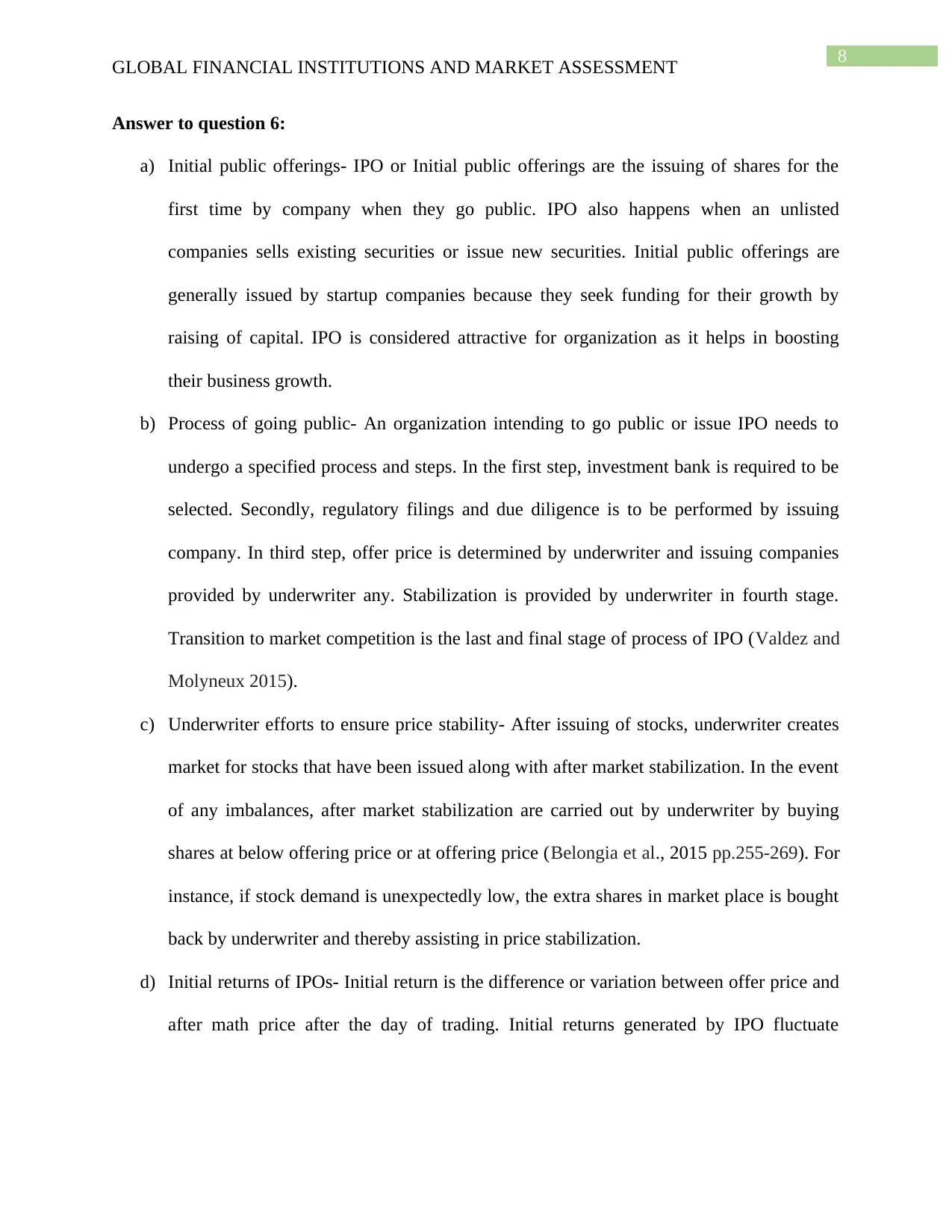
8
GLOBAL FINANCIAL INSTITUTIONS AND MARKET ASSESSMENT
Answer to question 6:
a) Initial public offerings- IPO or Initial public offerings are the issuing of shares for the
first time by company when they go public. IPO also happens when an unlisted
companies sells existing securities or issue new securities. Initial public offerings are
generally issued by startup companies because they seek funding for their growth by
raising of capital. IPO is considered attractive for organization as it helps in boosting
their business growth.
b) Process of going public- An organization intending to go public or issue IPO needs to
undergo a specified process and steps. In the first step, investment bank is required to be
selected. Secondly, regulatory filings and due diligence is to be performed by issuing
company. In third step, offer price is determined by underwriter and issuing companies
provided by underwriter any. Stabilization is provided by underwriter in fourth stage.
Transition to market competition is the last and final stage of process of IPO (Valdez and
Molyneux 2015).
c) Underwriter efforts to ensure price stability- After issuing of stocks, underwriter creates
market for stocks that have been issued along with after market stabilization. In the event
of any imbalances, after market stabilization are carried out by underwriter by buying
shares at below offering price or at offering price (Belongia et al., 2015 pp.255-269). For
instance, if stock demand is unexpectedly low, the extra shares in market place is bought
back by underwriter and thereby assisting in price stabilization.
d) Initial returns of IPOs- Initial return is the difference or variation between offer price and
after math price after the day of trading. Initial returns generated by IPO fluctuate
GLOBAL FINANCIAL INSTITUTIONS AND MARKET ASSESSMENT
Answer to question 6:
a) Initial public offerings- IPO or Initial public offerings are the issuing of shares for the
first time by company when they go public. IPO also happens when an unlisted
companies sells existing securities or issue new securities. Initial public offerings are
generally issued by startup companies because they seek funding for their growth by
raising of capital. IPO is considered attractive for organization as it helps in boosting
their business growth.
b) Process of going public- An organization intending to go public or issue IPO needs to
undergo a specified process and steps. In the first step, investment bank is required to be
selected. Secondly, regulatory filings and due diligence is to be performed by issuing
company. In third step, offer price is determined by underwriter and issuing companies
provided by underwriter any. Stabilization is provided by underwriter in fourth stage.
Transition to market competition is the last and final stage of process of IPO (Valdez and
Molyneux 2015).
c) Underwriter efforts to ensure price stability- After issuing of stocks, underwriter creates
market for stocks that have been issued along with after market stabilization. In the event
of any imbalances, after market stabilization are carried out by underwriter by buying
shares at below offering price or at offering price (Belongia et al., 2015 pp.255-269). For
instance, if stock demand is unexpectedly low, the extra shares in market place is bought
back by underwriter and thereby assisting in price stabilization.
d) Initial returns of IPOs- Initial return is the difference or variation between offer price and
after math price after the day of trading. Initial returns generated by IPO fluctuate
⊘ This is a preview!⊘
Do you want full access?
Subscribe today to unlock all pages.

Trusted by 1+ million students worldwide
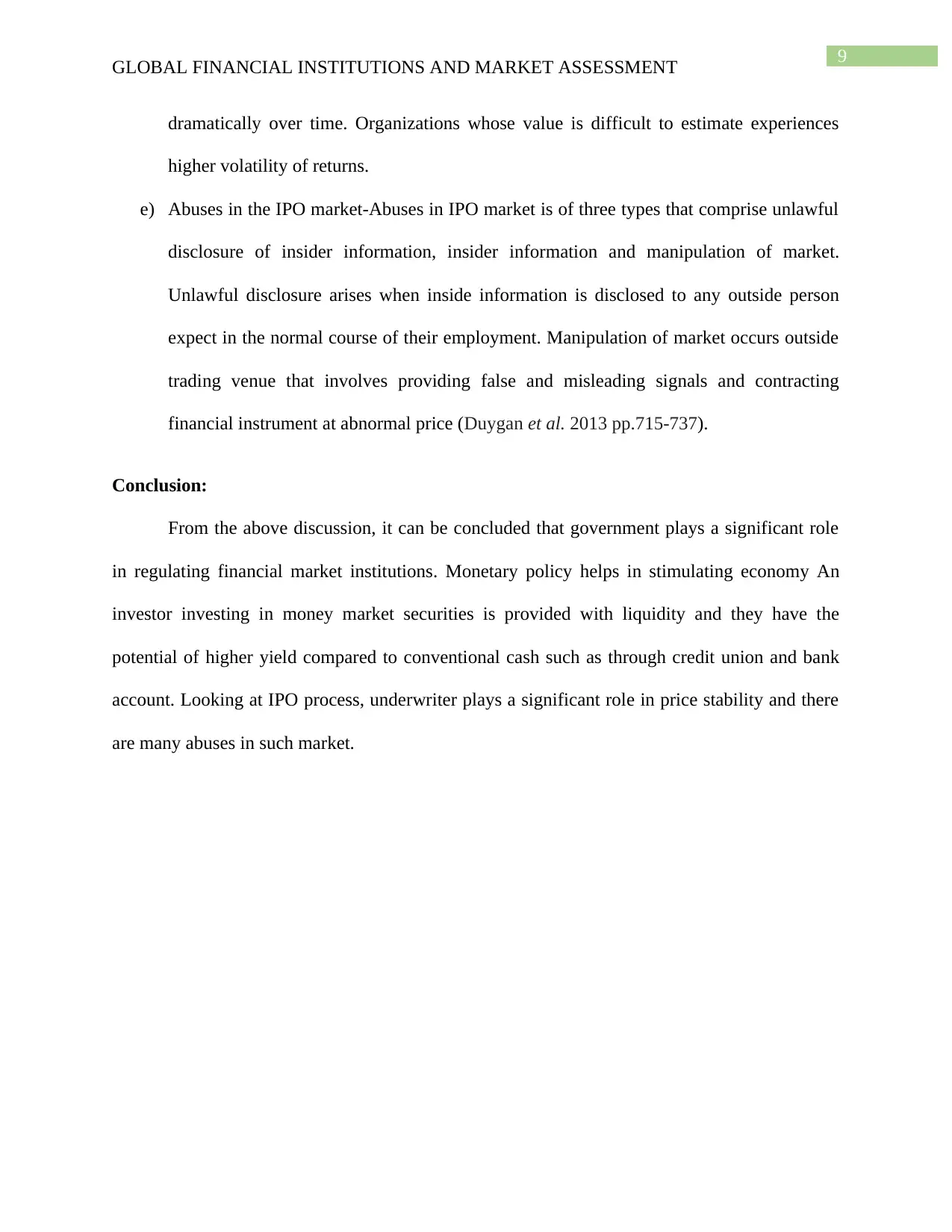
9
GLOBAL FINANCIAL INSTITUTIONS AND MARKET ASSESSMENT
dramatically over time. Organizations whose value is difficult to estimate experiences
higher volatility of returns.
e) Abuses in the IPO market-Abuses in IPO market is of three types that comprise unlawful
disclosure of insider information, insider information and manipulation of market.
Unlawful disclosure arises when inside information is disclosed to any outside person
expect in the normal course of their employment. Manipulation of market occurs outside
trading venue that involves providing false and misleading signals and contracting
financial instrument at abnormal price (Duygan et al. 2013 pp.715-737).
Conclusion:
From the above discussion, it can be concluded that government plays a significant role
in regulating financial market institutions. Monetary policy helps in stimulating economy An
investor investing in money market securities is provided with liquidity and they have the
potential of higher yield compared to conventional cash such as through credit union and bank
account. Looking at IPO process, underwriter plays a significant role in price stability and there
are many abuses in such market.
GLOBAL FINANCIAL INSTITUTIONS AND MARKET ASSESSMENT
dramatically over time. Organizations whose value is difficult to estimate experiences
higher volatility of returns.
e) Abuses in the IPO market-Abuses in IPO market is of three types that comprise unlawful
disclosure of insider information, insider information and manipulation of market.
Unlawful disclosure arises when inside information is disclosed to any outside person
expect in the normal course of their employment. Manipulation of market occurs outside
trading venue that involves providing false and misleading signals and contracting
financial instrument at abnormal price (Duygan et al. 2013 pp.715-737).
Conclusion:
From the above discussion, it can be concluded that government plays a significant role
in regulating financial market institutions. Monetary policy helps in stimulating economy An
investor investing in money market securities is provided with liquidity and they have the
potential of higher yield compared to conventional cash such as through credit union and bank
account. Looking at IPO process, underwriter plays a significant role in price stability and there
are many abuses in such market.
Paraphrase This Document
Need a fresh take? Get an instant paraphrase of this document with our AI Paraphraser
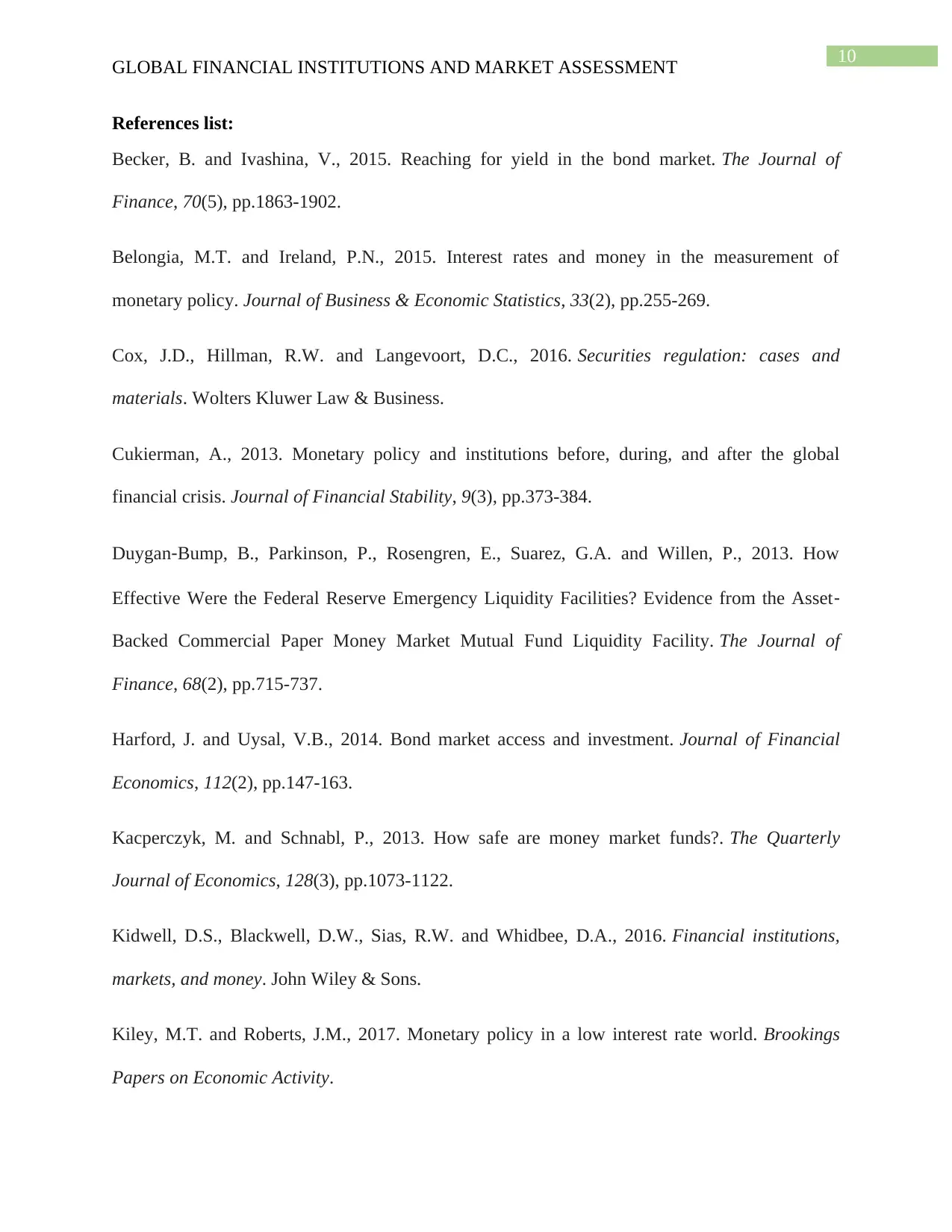
10
GLOBAL FINANCIAL INSTITUTIONS AND MARKET ASSESSMENT
References list:
Becker, B. and Ivashina, V., 2015. Reaching for yield in the bond market. The Journal of
Finance, 70(5), pp.1863-1902.
Belongia, M.T. and Ireland, P.N., 2015. Interest rates and money in the measurement of
monetary policy. Journal of Business & Economic Statistics, 33(2), pp.255-269.
Cox, J.D., Hillman, R.W. and Langevoort, D.C., 2016. Securities regulation: cases and
materials. Wolters Kluwer Law & Business.
Cukierman, A., 2013. Monetary policy and institutions before, during, and after the global
financial crisis. Journal of Financial Stability, 9(3), pp.373-384.
Duygan‐Bump, B., Parkinson, P., Rosengren, E., Suarez, G.A. and Willen, P., 2013. How
Effective Were the Federal Reserve Emergency Liquidity Facilities? Evidence from the Asset‐
Backed Commercial Paper Money Market Mutual Fund Liquidity Facility. The Journal of
Finance, 68(2), pp.715-737.
Harford, J. and Uysal, V.B., 2014. Bond market access and investment. Journal of Financial
Economics, 112(2), pp.147-163.
Kacperczyk, M. and Schnabl, P., 2013. How safe are money market funds?. The Quarterly
Journal of Economics, 128(3), pp.1073-1122.
Kidwell, D.S., Blackwell, D.W., Sias, R.W. and Whidbee, D.A., 2016. Financial institutions,
markets, and money. John Wiley & Sons.
Kiley, M.T. and Roberts, J.M., 2017. Monetary policy in a low interest rate world. Brookings
Papers on Economic Activity.
GLOBAL FINANCIAL INSTITUTIONS AND MARKET ASSESSMENT
References list:
Becker, B. and Ivashina, V., 2015. Reaching for yield in the bond market. The Journal of
Finance, 70(5), pp.1863-1902.
Belongia, M.T. and Ireland, P.N., 2015. Interest rates and money in the measurement of
monetary policy. Journal of Business & Economic Statistics, 33(2), pp.255-269.
Cox, J.D., Hillman, R.W. and Langevoort, D.C., 2016. Securities regulation: cases and
materials. Wolters Kluwer Law & Business.
Cukierman, A., 2013. Monetary policy and institutions before, during, and after the global
financial crisis. Journal of Financial Stability, 9(3), pp.373-384.
Duygan‐Bump, B., Parkinson, P., Rosengren, E., Suarez, G.A. and Willen, P., 2013. How
Effective Were the Federal Reserve Emergency Liquidity Facilities? Evidence from the Asset‐
Backed Commercial Paper Money Market Mutual Fund Liquidity Facility. The Journal of
Finance, 68(2), pp.715-737.
Harford, J. and Uysal, V.B., 2014. Bond market access and investment. Journal of Financial
Economics, 112(2), pp.147-163.
Kacperczyk, M. and Schnabl, P., 2013. How safe are money market funds?. The Quarterly
Journal of Economics, 128(3), pp.1073-1122.
Kidwell, D.S., Blackwell, D.W., Sias, R.W. and Whidbee, D.A., 2016. Financial institutions,
markets, and money. John Wiley & Sons.
Kiley, M.T. and Roberts, J.M., 2017. Monetary policy in a low interest rate world. Brookings
Papers on Economic Activity.
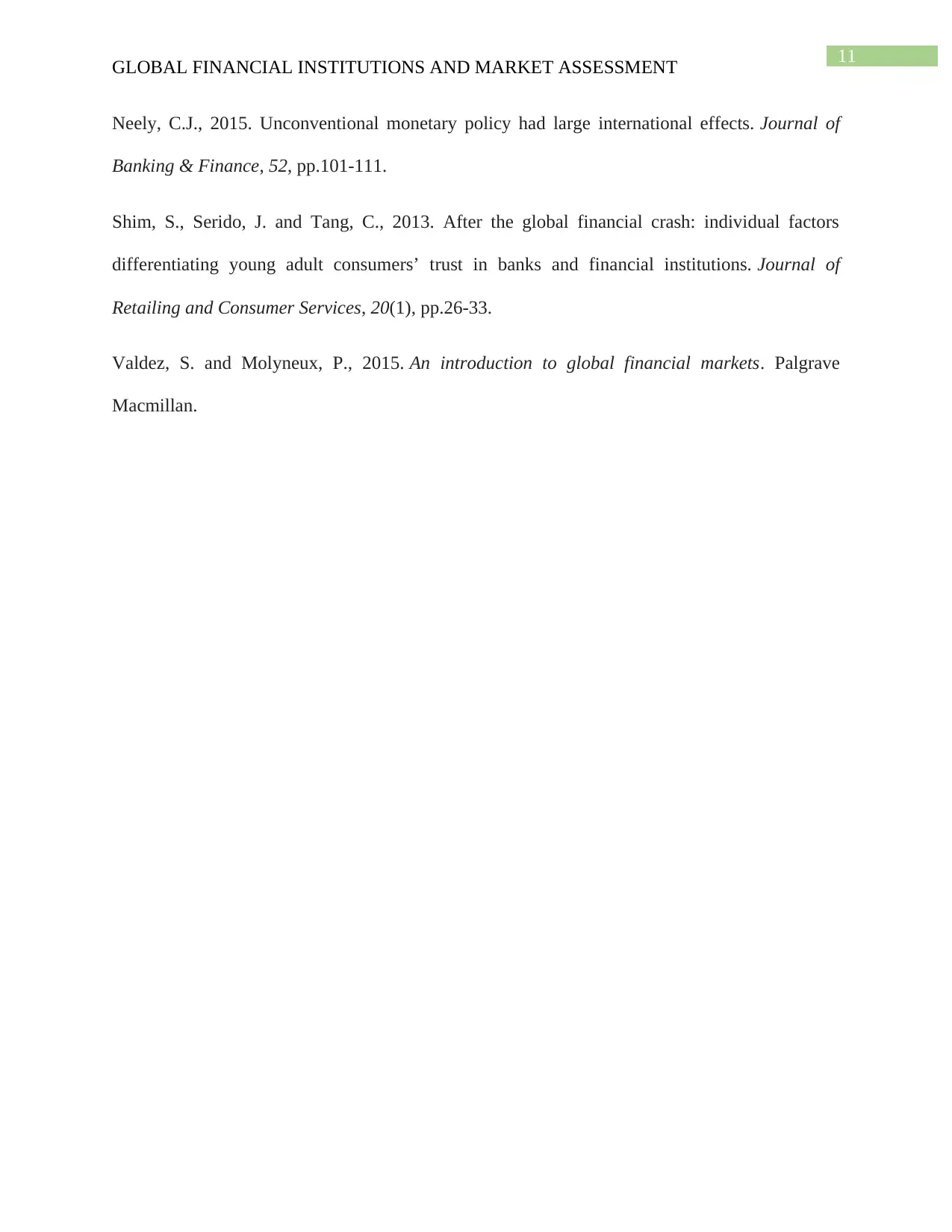
11
GLOBAL FINANCIAL INSTITUTIONS AND MARKET ASSESSMENT
Neely, C.J., 2015. Unconventional monetary policy had large international effects. Journal of
Banking & Finance, 52, pp.101-111.
Shim, S., Serido, J. and Tang, C., 2013. After the global financial crash: individual factors
differentiating young adult consumers’ trust in banks and financial institutions. Journal of
Retailing and Consumer Services, 20(1), pp.26-33.
Valdez, S. and Molyneux, P., 2015. An introduction to global financial markets. Palgrave
Macmillan.
GLOBAL FINANCIAL INSTITUTIONS AND MARKET ASSESSMENT
Neely, C.J., 2015. Unconventional monetary policy had large international effects. Journal of
Banking & Finance, 52, pp.101-111.
Shim, S., Serido, J. and Tang, C., 2013. After the global financial crash: individual factors
differentiating young adult consumers’ trust in banks and financial institutions. Journal of
Retailing and Consumer Services, 20(1), pp.26-33.
Valdez, S. and Molyneux, P., 2015. An introduction to global financial markets. Palgrave
Macmillan.
⊘ This is a preview!⊘
Do you want full access?
Subscribe today to unlock all pages.

Trusted by 1+ million students worldwide
1 out of 12
Related Documents
Your All-in-One AI-Powered Toolkit for Academic Success.
+13062052269
info@desklib.com
Available 24*7 on WhatsApp / Email
![[object Object]](/_next/static/media/star-bottom.7253800d.svg)
Unlock your academic potential
Copyright © 2020–2025 A2Z Services. All Rights Reserved. Developed and managed by ZUCOL.





